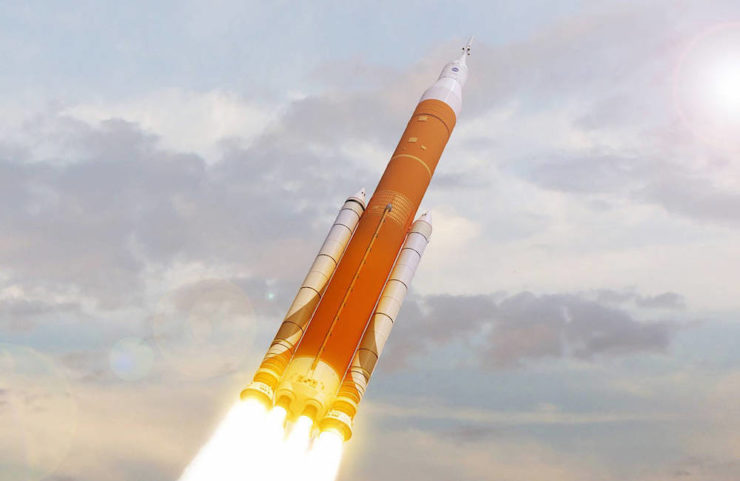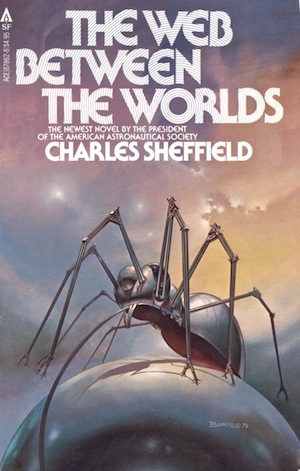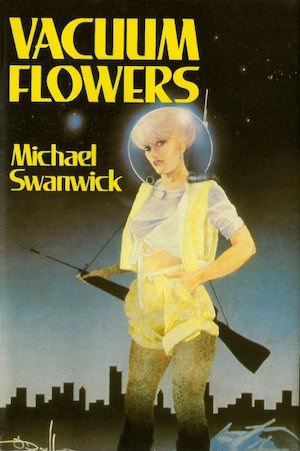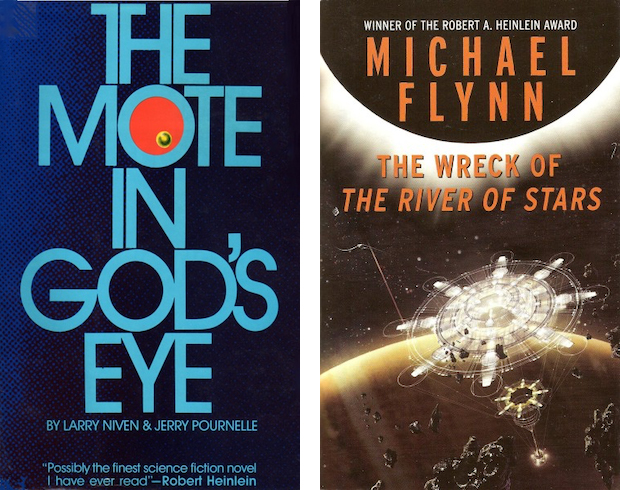Suppose one is a science fiction writer; further suppose that one wishes to depict delivery of a payload from point A to a point B across the vast gulfs of space. The obvious solution is to put the payload into a rocket. That’s not the only solution, however, and often it’s not the most appropriate one. Here are five somewhat plausible alternatives that authors have used to sidestep the inherent limitations of rockets1. (I have previously discussed convenient wormhole networks. Consider it done. Or possibly due for a revisit.)
Everyone is familiar with slings. Rotating structures in space can be used to impart momentum to payloads in much the same way. (The rotating object, having shed some momentum, would need to be sped up again; handwave an energy source). Depending on one’s assumptions about tensile strengths, one might be able lob payloads across the Solar System in long, slow orbits.
Although one could imagine all manner of scenarios in which slings (AKA tethers) might play a role in SF novels, generally they don’t. The most significant novel exploiting tether momentum transfer potential is the late Charles Sheffield’s The Web Between the Worlds. The same super-high-tensile-strength materials used to construct towers linking groundside to orbit can be used to hurl payloads at impressive velocities, without the mass-wastage of rockets. There is a catch, however (revealing which would be a spoiler).
A cousin to the sling is the accelerator, a (presumably firmly bolted down) device which uses some force other than centripetal to accelerate payloads. Such devices have some obvious limits (namely, power supply, heat management, and the trade-off between accelerations low enough not to crush the payload and final velocities high enough to be useful). They also have advantages, not least of which is not having to haul a gigawatt-plus power supply off-planet and across space. Accelerators of various kinds go way back in science fiction, at least as far as Jules Vernes’ From the Earth to the Moon, whose Baltimore Gun Club delivers a living payload past the Moon using a very, very large gun2. No, larger than that.
Various flavours of accelerators show up all through SF. One of the more striking examples is Michael Swanwick’s Vacuum Flowers, whose “transit rings” manipulate space-time to accelerate payloads to high speeds without the payloads feeling the forces involved. I wonder if this was inspired by Robert Forward’s Guidelines to Antigravity
There is an SF adage that spacers avoid gravity wells. Like so many SFnal adages, it’s wrong. Properly exploited, planets’ gravity is an exploitable resource despite the fact that gravity is such a pathetically weak force one needs an entire planet to create significant amounts of it. Choose your path carefully while falling past a planet and your course and velocity will be altered quite usefully. In fact, this is so obviously a useful technique it is used routinely by robot space probes in real life.
Perhaps the most cinematic use of flybys in SF occurs in Larry Niven’s Protector, in which neutron star BVS-1 multitasks by providing the protagonist and his companion both a necessary course correction for their Bussard ramjet and a memorable battleground on which to eliminate unwanted pursuers.
The most bug-fuck crazy use is in Robert Forward’s Saturn Rukh. Gravity is a very weak force with which to couple a space craft to a passing body. Always a bold thinker, Forward solved this problem by replacing gravity with inter-molecular forces. More specifically, with the inter-molecular forces found in high-tensile cables connected to the harpoons with which his characters skewered passing moons, letting the tethers impart momentum to their craft as each tether played out to its end. From Hell’s heart I stab at thee, indeed.
Solar sails, magsails, and their kin deliver glorious potential despite tiny acceleration. They take advantage of the fact that the sun provides (for no charge!) prodigious quantities of light and solar wind, both of which the cunning spacer can use for propulsion3. I’ve discussed sails before but one example I missed was Michal Flynn’s novel The Wreck of the River of Stars, in which a former magsail tramp freighter retrofitted with conventional fusion drives suffers a catastrophic drive failure. Redeploying the old sails is but one tactic to which the desperate crew turns.
Sunlight drops off according to the inverse square law but one can, as did the Moties in The Mote in God’s Eye, compensate for this with massive banks of lasers. The Moties settled for a lasers of merely Brobdingnagian scale, but of course much larger alternatives are possible.
If all else fails, one can simply send a sufficiently detailed description of the payload to the destination and have someone assemble a copy from the downloaded description. There are any number of pesky implementation details involved, from “how detailed is sufficiently detailed?” and “how precisely did the device doing the assembling arrive on the destination in the first place?” Still, the basic idea really isn’t any more implausible than emailing blueprints around the world. Wil McCarthy’s Queendom of Sol got impressive mileage out of a culture where scanning and re-creation was an everyday event (well, until people screwed up badly and it wasn’t).
Indeed, this method could in theory be used to span interstellar gulfs. Charlie Stross’ Saturn’s Children is an obvious example. Less well known: humanity dodges extinction in Donald Moffatt’s Genesis Quest by beaming genetic information out into the intergalactic gulfs. Humanity very nearly causes its own extinction in Hoyle and Elliott’s A for Andromeda, when bold scientists construct a device following instructions in an interstellar message. The device that results very much does not have humanity’s best interest at heart…
(But it looks exactly like Julie Christie, which I think makes up for a certain level of KILL ALL HUMANS.)
No doubt you have your own preferred methods for sidestepping rockets—feel free to berate me for overlooking them in the comments.
In the words of Wikipedia editor TexasAndroid, prolific book reviewer and perennial Darwin Award nominee James Davis Nicoll is of “questionable notability.” His work has appeared in Publishers Weekly and Romantic Times as well as on his own websites, James Nicoll Reviews and Young People Read Old SFF (where he is assisted by editor Karen Lofstrom and web person Adrienne L. Travis). He was a finalist for the 2019 Best Fan Writer Hugo Award, is one of four candidates for the 2020 Down Under Fan Fund, and is surprisingly flammable.
[1]Which isn’t to say that each replacement for rocketry does not have its own limits.
[2]How did the passengers in “From the Earth to the Moon” avoid being smeared into a very thin film of goo as the gun fired, you ask? Padding, and lots of handwaving by the author.
[3]I’m trying to restrict myself to plausible examples, but if I recall correctly, there’s at least one series, Alfred Coppell’s Goldenwing sequence, in which the sails reflect tachyons from a convenient source deeper within the galaxy. This does not allow them to exceed the speed of light, but it does conveniently permit nearlight speed travels.
















I seem to recall the robots in Dan Simmon’s Ilium using the electromagnetic field of Jupiter to create a sort of slingshot to get to Mars…?
Donald Kingsbury had an interesting proposal back in the Carter administration for an orbiting linear accelerator. Payloads would be tossed up at half orbital speed very exactly, caught by the accelerator and zipped up to orbital velocity. MV = mv so in the long the accelerator would fall out of orbit, which would be bad, so Kingsbury proposed payloads of metal-clad regolith would be dropped from the Moon to be slowed to orbital velocity by the accelerator.
@2 That sounds ridiculously hazardous to this layman.
One of the Gateway novels, I think Heechee Rendezvous, had a Lofstrom Loop.
Another interesting take on the accelerator idea was The Bridge To Space by Mike Combs:
Then on these hot air balloons, a mass driver providing 10G acceleration is built. It’s more efficient than launching from the ground because they float so high that the air is much thinner. I don’t remember if or how he addressed how you land a ship that you launched with no rockets on it, though …
Aerobraking, presumably, and if that is insufficient, a brief lithobraking phase.
I think Barry Malzberg wroite a short story about a spaceship that was being driven by the imagination of the crew: they just imagined the ship arriving at another star and … it did! This was an exercise in making the idealistic philosophy an applied… technology, the author said, probably in a prologue.
I remember the opening – the pilots were following the pre-launch check list and quietly discussing the passengers and one of the pilots said that they might have a problem with 17C (or whatever was the seat number) or rather with the person in that seat who did not believe that the ship would arrive at its destination. I don’t remember anything else and I am not sure it was Malzberg, but the idea was strikingly brilliant!
As I recall the flaw in the wish fulfillment drive sent them to Hell.
Frederic Pohl uses transmission and reduplication in the Saga of Cuckoo. And Greg Egan in Incandescence. And Tony Daniels in Warpath (he also has Native Americans paddling through hyperspace-rather like Lafferty in Past Master
Before the twentieth century, balloons were popular to take to the moon, see Edgar Allen Poe’s story The Unparalleled Adventure of One Hans Pfaall. But my personal favorite is the 1620 story Man in the Moone by Francis Godwin in which the hero flies to the moon on a kite pulled by swans, or wilde birds.
There’s always the “rotating space elevator” as a means of getting offworld. The center of mass of the thing rotates around the Earth, and the two ends of the device rotate around the center of mass – so that every once in a while, one end of the structure or the other dips into the atmosphere and is momentarily moving rather slowly relative to the surface, and is thus convenient for getting a lift to space. Sounds at least as safe as a paternoster elevator https://en.wikipedia.org/wiki/Paternoster
Ken MacLeod’s Corporation Wars trilogy uses the information as payload method to colonize an entire solar system.
The Wreck of the River of Stars is a wonderful book. I’m happy that you mentioned it.
@9 –
Shouldn’t that be “wilde byrdes”?
#9 – somewhat in the same vein, Cyrano de Bergerac sent his fictional self to the sun by strapping vials of dew to himself. When the dew evaporated in sunlight, up he went with it.
@seth Ellis:
Then he fell back down without ever getting to anywhere except “up”. He ends up reaching the moon by using rockets, so explicitly not appropriate for this particular Nicoll article.
And of course in Nathan Lowell’s series ‘The Golden Age of the Solar Clipper‘ the eponymous solar clippers use magnetic sails[1] to slowly, but very efficiently, maneuver themselves within star systems. (Though not every ship in that universe opts for that slow but efficient propulsion)
[1] the ‘sail’ formed by powerful electromagnetic fields projected from the ships is pushed by the charged particles of the solar wind; rather than by the star’s photons as with a classic physical solar sail.
Planoform ships of various configurations, in some of Cordwainer Smith’s stories (differing from the lightsails in, frex, “The Lady Who Sailed the Soul”)…
The improvability drive from the Hitchiker’s Guide to the Galaxy comes to mind. I don’t specifically recall if only the main ship used it or others did it too.
I recollect a really big orbiting wheel in SevenEves (which obviously has rockets used elsewhere, but it’s still cool), and of course 2001 famously had a gravity assist off Jupiter years before the Voyager proves would do it for real.
In the RPG Eclipse Phase, the Jovian Republic charges tolls for the use of gravitational slingshots around Jupiter. “That momentum ain’t free, buddy…”
Note that everything I mentioned is at least in theory possible, even if there are implementation issues.
For those wanting a visual of the “sling” method, check out 1998’s Bubblegum Crisis Tokyo 2040. I can’t find any good screenshots or clips, but a sling is used toward the end of the series to get the heroes into space (previously, it was used offscreen to loft cargo).
The process involves matching velocities (there’s a “runway” on the surface with traincar-like cargo haulers), until the cargo (or motorcycle-riding superheroes) can be “handed” up to/down from the ship-like end of the tether as it passes overhead.
Hassan @@@@@ 17 – that would be the infinite improbability drive, though I have to say I rather like the idea of an improvability drive. Sort of gets better with practice?
Does the Pinlighter drive (Game of rat and dragons) count?
Pohl was very taken with the Lofstrom Launch Loop, at least in his fiction.
I think one of his non-Gateway books had one too, sited in South America, with a plot element about what’s involved in “ditching” it in the event of an accident, disaster, or sabotage – the amount of kinetic energy that needs to be dissipated as heat is enough to boil a good-sized body of water.
@17: you meant to type Improbability Drive. It’s somewhat a plot point that it is installed in the starship “Heart of Gold” which Zaphod Beeblebrox has stolen, and it’s also shown that operating it willy-nilly has drastic effects on objects in the vicinity, so the ship uses the ordinary methods, whatever they are, to get up into space so it doesn’t have one. In a sequel, the Bistromathic Drive is announced as a replacement for improb in nearly the same sentence as was used to explain why improb is better (or not) than “all that tedious mucking about in hyperspace”. Travel in hyperspace is compared to being drunk, as a glass of water is drunk.
James Blish had a spindizzy drive
I’m not sure what the rules of this game are.
SF authors must have created hundreds to thousands of ways to travel in space(?) or even between the stars (?), many of which are outright impossibility, others are plausibly scientific under certain conditions., ones where the engineering and economics are the challenge, some of which are handwavium or not really explained , or sufficiently advanced so as to be indistinguishable from magic.
Starting from historic “drawn by swans to the moon” to verne’s gun to star trek transporter beams to alcubierre warp drives, wormholes, hyperdrives, etc
Speaking of transmitting instructions, Sagan’s Contact had aliens transmit instructions; the resulting machine worked in mysterious ways…
I’m also partial to Greg Bear’s Moving Mars, where you edit the registers of the universe , essentially using a ‘QL Thinker’ to alter the laws of the universe resulting in the title.
You could argue that mass drivers/railgun drives are examples of “rockets” as is project orion, where you use exploding nuclear bombs to propel yourself as they both use newtons’s second law of motion.
@22,
Pinlighters were the human/feline teams that protected the ships from subspace dragons
I stand (albeit less steadily) where I stood in 1971: if Julie Christie proposed KILL ALL HUMANS to me, I would do my very best to dissuade her over an evening of choice cabaret, fine dining, and as many after-dinner liqueurs as it took.
Does Alastair Reynolds’ Merlin stories count? In then interstellar travel is accomplished by c-fractional ‘roads’ in space. Get in one with the right gear and you’re suddenly moving at a significant fraction of the speed of light without acceleration. This means interstellar dogs can be much smaller. But where you can go is limited to where these roads go.
Anyway, I liked them and wish Reynolds would publish a fix up of them.
@23: if the Lofstrom loop is in “Heechee Rendezvous”, its accident management features (a lake to drop it in) are discussed and demonstrated there. Of course you can have the same thing in another book, particularly if someone else invented it anyway.
29 I was trying to stick to real physics (although granted smoke rings of neutronium have implementation issues). Regions of space-time with different rules would fall into this old essay of mine,